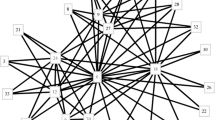Abstract
It is shown that whenever the edges of a connected simple graph on n vertices are colored with \(n-1\) colors appearing so that no cycle in G is rainbow, there must be a monochromatic edge cut in G. From this it follows that such colorings of G can be represented, or ‘encoded,’ by full binary trees with n leaves, with vertices labeled by subsets of V(G), such that the leaf labels are singletons, the label of each non-leaf is the union of the labels of its children, and each label set induces a connected subgraph of G. It is also shown that \(n-1\) is the largest integer for which the main theorem holds, for each n, although for some graphs a certain strengthening of the hypothesis makes the theorem conclusion true with \(n-1\) replaced by \(n-2\).




Similar content being viewed by others
Notes
The reason for the terminology is that one of the co-authors was first introduced to the topic of RCF edge colorings by Jenö Lehel.
References
Johnson, P., Owens, A.: Edge colorings of complete multipartite graphs forbidding rainbow cycles. Theory Appl. Graphs 4(2), 9 (2017) (article 2)
Gouge, A., Hoffman, D., Johnson, P., Nunley, L., Paben, L.: Edge colorings of \(K_n\) which forbid rainbow cycles. Utilitas Math. 83, 219–232 (2010)
Johnson, P., Zhang, C.: Edge colorings of \(K_{m, n}\) with \(m+n-1\) colors which forbid rainbow cycles. Theory Appl. Graphs 4(1), 17 (2017). Article 1
Fujita, S., Magnant, C., Ozeki, K.: Rainbow generalizations of Ramsey Theory—a dynamic survey. Theory Appl. Graphs (1), 1 (2014). https://doi.org/10.20429/tag2014.000101. http://digitalcommons.georgiasouthern.edu/tag/vol0/iss1/1(p. 38)
Jendrol’, S., Mis̆kuf, J., Soták, R., S̆krabul’áková, E.: Rainbow faces in edge-colored plane graphs. J. Graph Theory 62, 84–99 (2009)
Graham, R.L., Pollak, H.O.: On the addressing problem for loop switching. Bell Syst. Tech. J. 50(8), 2495–2519 (1971)
Alon, N.: Bipartite decomposition of random graphs. J. Comb. Theory Ser. B 113, 220–235 (2015)
Alon, N., Bohman, T., Huang, H.: More on the bipartite decomposition of random graphs. J. Graph Theory 84, 45–52 (2017)
Chung, F., Peng, X.: Decomposition of random graphs into complete bipartite graphs. SIAM J. Discrete Math. 30(1), 296–310 (2016)
Author information
Authors and Affiliations
Corresponding author
Additional information
Publisher's Note
Springer Nature remains neutral with regard to jurisdictional claims in published maps and institutional affiliations.
Paul Horn and Peter Johnson’s research was partially supported by NSF grant DMS-134365. Paul Horn’s research was partially supported by Simons Collaboration Grant 525039 and a University of Denver Internationalization Grant.
Rights and permissions
About this article
Cite this article
Hoffman, D., Horn, P., Johnson, P. et al. On Rainbow-Cycle-Forbidding Edge Colorings of Finite Graphs. Graphs and Combinatorics 35, 1585–1596 (2019). https://doi.org/10.1007/s00373-019-02102-6
Received:
Revised:
Published:
Issue Date:
DOI: https://doi.org/10.1007/s00373-019-02102-6




